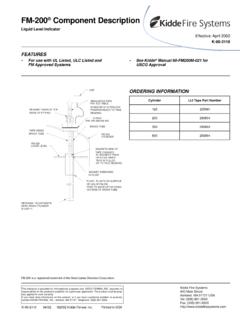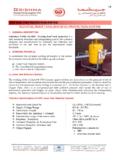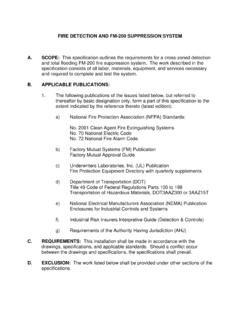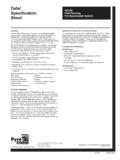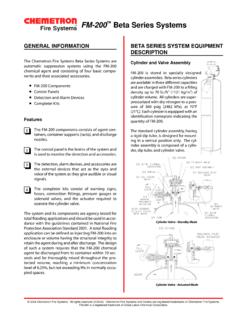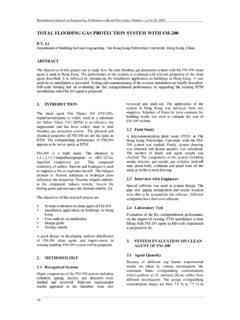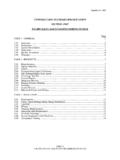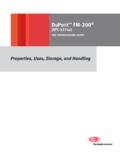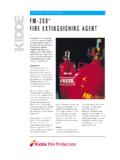Transcription of Kidde AEGIS Conventional Fire Alarm-Suppression …
1 A UTC fire & Security CompanyEffective: March 200784-100 AEGIS Conventional fire Alarm-Suppression control UnitFEATURES Agency Approvals FM Approved FM Approved to ANSI/UL 864, 9th edition FM Approved to ULC-S527-99 Other domestic approvals/listings pending/in-process suppression focused control Unit Listed for a Wide Range of suppression Systems Kidde FM-200 , FE13TM, CO2, 3 MTM Novec 1230 fire Protection Fluid, ArgoniteTM, and HalonClean Agents Kidde IND Dry Chemical & WHDR WetChemical Systems Sprinkler Supervisory Service Deluge, Preaction, Foam, Foam-Water Systems Combination Clean Agent plus Pre-Action System Built-in Class-A and Class-B Circuitry Sophisticated Programmable Notification ApplianceCircuits Independently Programmable Agent Releasing Circuitswith Triple-R ProtectionDESCRIPTIONThe Kidde AEGIS is the technologically most advanced Con-ventional Single Hazard Agent Releasing Unit available tothe fire -Alarm suppression industry today.
2 It combines thehigh quality, system reliability, and flexibility required bymodern commercial, high-tech and industrial applicationsin an aesthetically pleasing and physically robust AEGIS is well equipped to handle all special hazardextinguishing systems due to the high degree of program-ming flexibility provided and the following full complementof input and output circuits: Three (3) Class A or Class B Detection Circuits Two (2) Class A or Class B SupervisoryCircuits One (1) Class A or Class B Manual Release Circuit One (1) Class A or Class B Abort Input Circuit Three (3) Class A or Class B Notification ApplianceCircuits Two (2) Class B Agent Release Circuits Four (4)
3 Form-C Relays Input and Output 3 Detection Circuits 2 Supervisory Circuits 1 Manual Release Circuit 1 Abort Input Circuit 3 Notification Appliance Circuits 2 Release Circuits 4 Form-C Relays Programmable Relays Robust Power Supply Elegant User-Interface Simple Configuration Password Protected Digital Release Countdown Battery Voltage and Charging Current Display Extensive Diagnostics Backwards Compatible Improved and Enlarged Cabinet Design 5-Year Warranty2 DETECTION CIRCUITSThe Detection Circuits can support up to 25 ConventionalCPD-705x Ionization Smoke, PSD-715x PhotoelectricSmoke, or THD-705x Heat Detectors each as well as Nor-mally Open contact closure type devices.
4 Two circuits arededicated to the main suppression function and can be pro-grammed to activate the release circuits by either single-shot or cross-zone input. The user-configuration allowsautomatic release via detection to be delayed from 0 to 60seconds in 10-second intervals and also allows a choice ofwhich of the two Agent Release Circuits to third Detection Circuit is programmable for eitherWaterflow or as an independent Detection circuit. Whenprogrammed for Waterflow, Notification Appliance Circuitscan be programmed as Non-Silenceable as required bycertain CIRCUITSThe Supervisory Circuits accept Normally Open contact clo-sure type devices such as pressure switches on the agentcylinders or on the water or air pipe network.
5 The systemconfiguration enables the supervisory input to be a partici-pant in the suppression function. For example, low air su-pervisory can be included with detection for release ofpre-action systems as required by certain 1. Printed Circuit Board (PCB)MANUAL RELEASE AND ABORT CIRCUITSBoth the Manual Release and Abort Circuits accept Nor-mally Open contact closure type devices. Activation of theAgent Release Circuits can either be instantaneous or de-layed up to 30 seconds (maximum) upon receipt of ManualRelease input. Agent release can be temporarily delayedby activating the Abort Circuit.
6 The Abort input can be pro-grammed for 5 modes of operation. These include the UL10-second mode, the full-delay mode, the IRI mode, theNYC mode, or the abort can be disabled. Aborts can alsobe programmed to be applicable for either one or both AgentRelease Circuits thereby allowing use with Deluge/Pre-Ac-tion APPLIANCE CIRCUITS (NAC)The three Notification Appliance Circuits are rated Ampseach and accept polarized 24 VDC Notification the three circuits, NAC 1 activates on First Alarm, NAC 2in Pre-Release condition and NAC 3 in Releasing condi-tion. Each circuit is driven independently and is userconfigurable for 60 BPM, 120 BPM, Temporal, or Continu-ous MT and NS series appliances provide the option to usesilenceable horns and non-silenceable strobes on the sameNAC.
7 Multiple NAC circuits (connected to audible devicesonly) programmed with the same master code pattern aresynchronized, regardless of any differing starting times thatpreceded their concurrent operation. The NACs configura-tion includes a user-selectable intelligent synchronizationfeature which allows a silenceable horn to be shut off whilethe strobe continues to flash in synchronized 1 DETECTOR 2 WATERFLOW/DETECTOR 3 MANUALRELEASEABORTSUPERVISORY1 SUPERVISORY2 TROUBLERELAY 3 RELAY 2 RELAY 1 BATT OUTAC INRELEASE 1 ARC 1 RELEASE 2 ARC 2 AUX24 VDCNAC 3 NAC 2 NAC 1AC SUPPLY SELECT SWITCH (S6)3 BUILT-IN CLASS A AND B CIRCUITRYFor the input and NAC circuits, the choice of Class A orClass B supervision is made at site on the board itself byselecting the terminals used for wiring.
8 Neither conversionboards nor additional hardware nor jumper selection is re-quired for this RELEASE CIRCUITS (ARC)The two circuits can be programmed for activation by dif-ferent inputs, with independent time delays and abort modesto fire combinations of two of the following releasing de-vices: 1 or 2 Kidde Continuous and Momentary SolenoidControl Heads 1 Kidde Initiator 1 Factory Mutual Group A, B, D, E, F, G, I, J, or KSolenoidIn other words, operating in tandem, the two circuits canrelease: 1 or 2 control Heads on ARC1 and 1 or 2 ControlHeads on ARC2 1 or 2 control Heads on ARC1 and 1 Initiator on ARC2or vice-versa 1 or 2 control Heads on ARC1 and 1 FM SprinklerSolenoid on ARC2 or vice-versa 1 Initiator on ARC1 and 1 Initiator on ARC2 1 FM Solenoid on ARC1 and 1 FM Solenoid on ARC2 This configurability is useful for those jurisdictions wherethe gaseous suppression agent is required to be supple-mented with a pre-action PROTECTION FOR AGENT RELEASINGCIRCUITS (ARC)
9 The two ARCs feature a triple failure redundancy safeguardsystem to protect them from inadvertent activation by themain microprocessor. The Triple-R system requires that inorder to activate an ARC, the main microprocessor issuestwo release commands of opposing polarity via separatechannels and that these commands be combined with athird signal from the panel watchdog timer to confirm themicroprocessor operation. The Triple-R system ensures thatelectrical transients or disturbances such as power surgesthat could interfere with the operation of the main micropro-cessor will not inadvertently activate the connected sup-pression system.
10 The result is a more robust and reliablesuppression-focused RELAYSOf the 4 relays, three are user-programmable for a varietyof alarm related conditions and the fourth is a dedicatedtrouble relay. All relay contacts are rated Amps at 30 VDC/120 VAC (resistive).POWER-LIMITED CIRCUITRYAll circuits, excluding ARCs are inherently Release Circuits, except when firing Initiators, canalso be made power-limited by a field located inline releas-ing diode device thereby allowing cost effective installationwith all wiring in the same POWER SUPPLY UNIT (PSU)The AEGIS features a universal 120/240 V, 50/60 Hz ACPower Supply Unit with a robust Amps of 24 VDC voltage selection is via a slider switch with no jumpercutting required.









